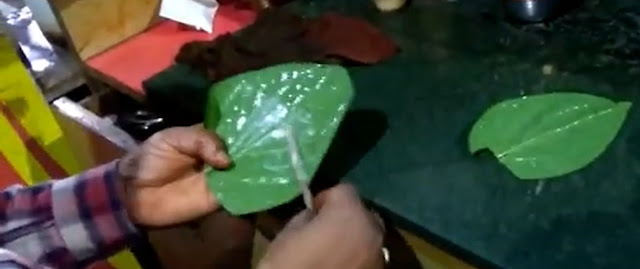Paan
 |
| Paan Paan |
Paan is a traditional Indian mouth freshener that has been consumed for centuries. It is typically made by wrapping a mixture of betel nut, areca nut, and various spices in a betel leaf to create a small, easily consumable parcel. The leaves are often smeared with a lime paste and sprinkled with a range of spices, including fennel seeds, cardamom, and cinnamon, to create a unique and aromatic flavor.
Paan comes in a variety of flavors, with options ranging from sweet to savory. The most common types of paan are meetha paan, which is a sweet, syrupy version, and saada paan, which is a simpler, unsweetened variety. Other variations include chocolate paan, strawberry paan, and mango paan.
Paan is consumed for a number of reasons. In addition to its refreshing taste, it is believed to have medicinal properties, particularly for digestive ailments. The betel nut and areca nut contain alkaloids that have a mild stimulating effect, while the spices used in paan have digestive properties that help to soothe the stomach.
Paan also has cultural significance in India, particularly in the northern regions of the country. It is often served at weddings and other celebrations as a symbol of hospitality, and is also used in religious ceremonies as an offering to the gods. Paan is also a popular street food in many parts of India, particularly in Delhi and other large cities.
Despite its popularity, paan has been linked to a number of health concerns. The betel nut used in paan contains arecoline, a psychoactive alkaloid that can be addictive and is also known to cause oral cancer. Other health risks associated with paan consumption include staining of the teeth and tongue, bad breath, and an increased risk of gum disease.
In recent years, efforts have been made to promote healthier versions of paan that do not contain betel nut or other harmful ingredients. These "pan masalas" are made with ingredients such as fruit pulp, mint, and saffron, and are marketed as a safer alternative to traditional paan.
Overall, paan is a unique and flavorful part of Indian culture. While it is important to be aware of the health risks associated with paan consumption, it remains a popular and beloved tradition for many people in India and around the world.
पान
 |
| पान पान |
पान एक पारंपरिक भारतीय माउथ फ्रेशनर है जिसका सदियों से सेवन किया जाता रहा है। यह आम तौर पर सुपारी, सुपारी, और विभिन्न मसालों के मिश्रण को पान के पत्ते में लपेटकर एक छोटा, आसानी से उपभोग करने योग्य पार्सल बनाया जाता है। एक अद्वितीय और सुगंधित स्वाद बनाने के लिए पत्तियों को अक्सर चूने के पेस्ट के साथ मिलाया जाता है और सौंफ के बीज, इलायची और दालचीनी सहित कई प्रकार के मसालों के साथ छिड़का जाता है।
पान कई प्रकार के स्वादों में आता है, जिसमें मीठे से लेकर नमकीन तक के विकल्प होते हैं। पान के सबसे आम प्रकार हैं मीठा पान, जो एक मीठा, सिरप वाला संस्करण है, और सादा पान, जो एक सरल, बिना मिठास वाली किस्म है। अन्य विविधताओं में चॉकलेट पान, स्ट्रॉबेरी पान और आम पान शामिल हैं।
पान का सेवन कई कारणों से किया जाता है। इसके ताज़ा स्वाद के अलावा, यह माना जाता है कि इसमें औषधीय गुण होते हैं, विशेष रूप से पाचन संबंधी बीमारियों के लिए। सुपारी और सुपारी में अल्कलॉइड होते हैं जिनका हल्का उत्तेजक प्रभाव होता है, जबकि पान में इस्तेमाल होने वाले मसालों में पाचन गुण होते हैं जो पेट को शांत करने में मदद करते हैं।
पान का भारत में सांस्कृतिक महत्व भी है, खासकर देश के उत्तरी क्षेत्रों में। यह अक्सर शादियों और अन्य समारोहों में आतिथ्य के प्रतीक के रूप में परोसा जाता है, और इसका उपयोग धार्मिक समारोहों में देवताओं को भेंट के रूप में भी किया जाता है। पान भारत के कई हिस्सों में एक लोकप्रिय स्ट्रीट फूड भी है, खासकर दिल्ली और अन्य बड़े शहरों में।
इसकी लोकप्रियता के बावजूद, पान को कई स्वास्थ्य संबंधी चिंताओं से जोड़ा गया है। पान में इस्तेमाल की जाने वाली सुपारी में एस्कोलाइन होता है, एक साइकोएक्टिव अल्कलॉइड जो नशे की लत हो सकता है और मुंह के कैंसर का कारण भी माना जाता है। पान के सेवन से जुड़े अन्य स्वास्थ्य जोखिमों में दांतों और जीभ का धुंधला होना, सांसों की बदबू और मसूड़ों की बीमारी का खतरा बढ़ जाना शामिल है।
हाल के वर्षों में, पान के स्वस्थ संस्करणों को बढ़ावा देने के प्रयास किए गए हैं जिनमें सुपारी या अन्य हानिकारक तत्व शामिल नहीं हैं। ये "पान मसाले" फलों के गूदे, पुदीना और केसर जैसी सामग्रियों से बनाए जाते हैं, और पारंपरिक पान के सुरक्षित विकल्प के रूप में विपणन किए जाते हैं।
कुल मिलाकर, पान भारतीय संस्कृति का एक अनूठा और स्वादिष्ट हिस्सा है। जबकि पान के सेवन से जुड़े स्वास्थ्य जोखिमों के बारे में जागरूक होना महत्वपूर्ण है, यह भारत और दुनिया भर में कई लोगों के लिए एक लोकप्रिय और प्रिय परंपरा बनी हुई है।

0 comments:
एक टिप्पणी भेजें
Please donot push any spam here.